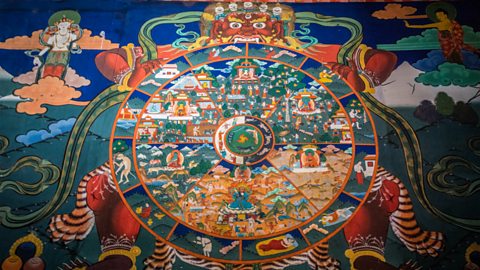Buddhist beliefs and how they differ
There are various beliefs in Buddhism that are centred around reaching enlightenmentThe realisation of the truth about life. In Buddhism it releases a person from the cycle of rebirth. and ending suffering (also called dukkha.
The Wheel of Life
The BuddhaThe founder of Buddhism, Siddhartha Gautama, after his enlightenment. It is a title which means the enlightened or awakened one. taught that all human experience is ultimately tainted by dukkha. Often translated as suffering, dukkha refers also to the sense of unsatisfactoriness, which the Buddha believed was ever-present. The Buddha taught that dukkha has various causes and effects. The idea of karma/kammaActions, and the consequences of actions. An important concept in Buddhism, Hinduism and Sikhism. (kamma is also known as karma) is that actions have consequences.
The The Wheel of LifeAn image within Buddhism that represents the idea of Samsara. (Bhavachakra) represents the idea in Buddhism of life, death and rebirth. This idea is also known as samsaraIn Hinduism, Buddhism and Sikhism, this is the cycle of life, death and rebirth.. Buddhists believe that what they are reborn as in future will depend on how they live their current life. For example, if a person lives a good life and has good kamma, they will be reborn into a better realm.

The Wheel of Life is a way of picturing the beliefs of samsara. The wheel has seven elements:
- The inner hub of the wheel shows the Three PoisonsThe main causes of suffering: greed, hatred and ignorance., which are ignorance, attachment (or greed) and hatred.
- The second layer represents kamma.
- The third layer represents the six realms of samsara.
- The fourth layer represents the 12 links of dependent arising (or paticca-samuppadaThe idea that everything is interconnected and that everyone affects everyone else.).
- The demon figure over the wheel represents the idea that nothing lasts forever (impermanenceNot lasting forever.).
- The moon above the wheel represents the idea of liberation or freedom from samsara.
- The BuddhaThe founder of Buddhism, Siddhartha Gautama, after his enlightenment. It is a title which means the enlightened or awakened one. pointing towards the white circle shows the idea that it is possible for people to become free from samsara.
The Four Noble Truths
The Four Noble TruthsThe truths discovered by the Buddha during his enlightenment. are one of the most important teachings of the Buddha. They consist of the following ideas:
- All life is imperfect and involves suffering (dukkhaSuffering, illness, dissatisfaction or imperfection. An unavoidable fact of existence according to the first Noble Truth of Buddhism.).
- The cause of suffering is desire (samudaya).
- Suffering can end (nirodha).
- The way to end suffering is by following the Noble Eightfold Path (magga).